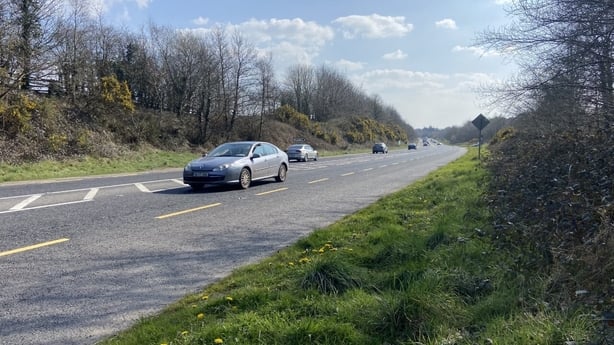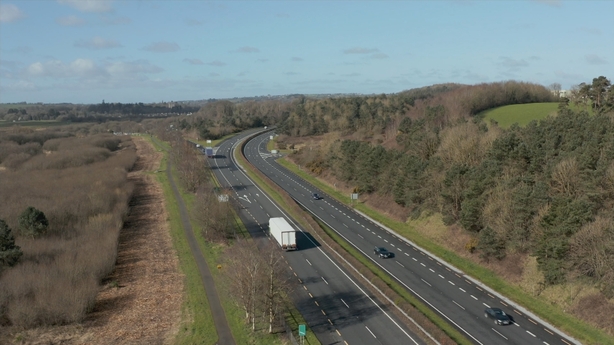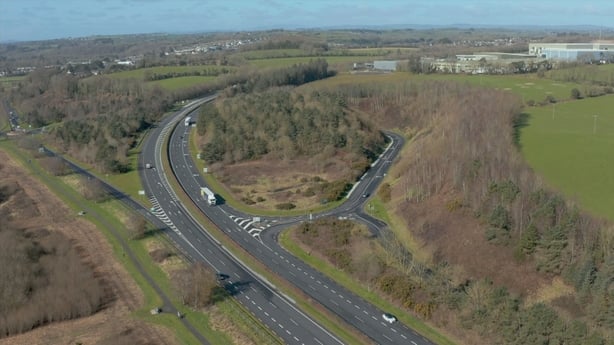The project team tasked with upgrading transport links between Cork and Limerick has published its preferred route.
The new road will re-use up to 40% of the existing N20.
It will involve the construction of 80km of what is described as high-quality dual carriageway.
There will also be upgrades to the rail link between the two cities, with the development of an hourly, "no change" service.
Journey times for express bus services will be reduced by 30 minutes each way.
Active travel infrastructure, to encourage walking and cycling along the route, will also be developed.
The project carries a price tag estimated at between €1 billion and €1.5 billion.
The preferred road route, beginning in Cork, extends north past Blarney and Mourneabbey along the existing N20, before it tracks east of Mallow, New Twopothouse and Buttevant, and west of Ballyhea, Charleville and Banogue.

It will join the existing M20 motorway to Limerick at Patrickswell.
A commitment to upgrade the route between Cork and Limerick was agreed in the Programme for Government. It is also a key element of the Government's Ireland 2040 plan.
Today's announcement was much anticipated in Cork and Limerick.
In some communities which do not lie along the preferred route, there will be celebrations. In those which do lie along the preferred route, there will almost certainly be anger and talk of legal challenges.
Letters have already been drafted to more than 2,000 people, telling them their homes, farms and businesses may be impacted directly or indirectly by the new route.
We need your consent to load this rte-player contentWe use rte-player to manage extra content that can set cookies on your device and collect data about your activity. Please review their details and accept them to load the content.Manage Preferences
Farmer Jimmy Sheehy, who lives at Granagh in Co Limerick, will have 20 acres of his 170-acre dairy farm cut off as a result of the proposed carraigeway.
He said he is "extremely unhappy" with the announcement, as it has major implications for his farm and livelihood.
He and his neighbours have lived with, what he described as, this "bothersome" project for the past 11 years which has completely disrupted their lives, and it looks now as if it will go on for another 11 years.
"I could be dead and gone before this road will ever be built," he said.
"We've dealt with this project for the past 11 years, and now we have another 11 ahead of us. It's heartbreaking. I found the project team very difficult to deal with and I believe they didn't listen to me.
"This road will drive through 13 acres of my land in the beautiful Golden Vale, and cut off another 7 acres while they build it. It's been nothing but bother and disruption for all those years," he said.
Mike Carroll, another Limerick farmer who lives along the route, said the "big ugly motorway" will bulldoze through his land, and have a profoundly negative effect on his life and the lives of his family.
"Everybody agrees the road needs improvement, but here in my locality it's going to have a massive impact on our quality of life, the exceptional quality of life generations of my family have enjoyed up to now. It will cut off access to my parents home, and leave me with miles to journey to reach my animals. It is lifechanging in a completely negative way the impact it will have," he said.

The properties may be impacted, directly or indirectly, and could be acquired for the new road by compulsory purchase.
The channel or corridor of the new route is 500 metres wide. There are 700 individual properties currently lying in the path of the new route.
However, the channel will eventually be narrowed to 100 metres wide by the time the final route is decided and designed. At that stage, the number of properties lying under the route is expected to be reduced to around 300.
The main reasons for upgrading the route, according to Project Coordinator Jari Howard, are economic and safety.

The project team says 62 people have died in road crashes on the N20 over the past 25 years.
It also says an analysis of road collision figures on the route between 2016 and 2018 showed crashes on the N20 were four times more likely to be fatal than the national average.
"The priority reason is that the road is not fit for purpose," Mr Howard said.
"It's over capacity. It's a legacy road that just can't deal with the current traffic and it's too much of a risk to society."
He said the economic reasons for investing in the project are also compelling.

Locally, it will present an opportunity to develop towns like Mallow and Charleville. Nationally, there are benefits from developing a western corridor.
"I think the economic benefit to the region and to the country as a whole is a massive opportunity," Mr Howard said.
"The Atlantic economic corridor, connecting Cork, Limerick, up to Galway along the west coast, is an opportunity to make a real counter-balance to the east coast and Dublin."
He accepted, however, that those whose properties may be impacted, or who will lose their homes will have to pay a price for the benefits which developing the route will bring.
"When you are building such large infrastructure, it's impossible to avoid those kind of impacts," Mr Howard said.
"We obviously try to minimise it as much as we can, and to mitigate them. But for people who may have to sell their house, that is a huge life-changing thing so there is no doubt that is going to be our priority for this phase going forward."
There is still much work to be done before machinery begins to roll on the ground.
Identification of the land required and detailed environmental evaluation will have to be completed.
An environmental impact assessment and a business case will have to be prepared. The project will have to be approved by Government.
Planning permission will also have to be secured and this will involve an oral hearing.
For all these reasons, it is likely to be 2030 or beyond before the upgraded N/M20 is delivered.
Additional reporting: Cathy Halloran







